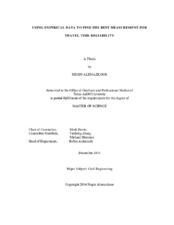| dc.description.abstract | The value of travel time savings (VTTS) is often the largest benefit from transportation projects. As a result, the value of time (VOT) has been studied extensively. Recently, additional attention has been paid to the fact that travelers also benefit from reliable travel times. Thus, the value of reliability (VOR) is beginning to factor into cost/benefit analyses of transportation projects and understanding travelers’ mode and route choices. VOR has almost always been estimated through stated preference data or survey based revealed preference data. In this research, empirical data was used in an attempt to estimate VOR.
The first concern regarding estimating VOR from empirical data is the lack of a definitive measurement for reliability. In this research, data from Katy Freeway, where travelers choose between tolled but reliable lanes and free but less reliable lanes, was used in an attempt to find the best measurement of reliability that could lead to the best explanation of travelers’ lane choice. Multinomial logit models and mixed logit models were used to estimate travelers’ lane choice based on trip attributes including travel time, travel time reliability and toll. Although models including only travel time and toll yielded reasonable results and VOTs ($2.78/hr, $9.09/hr, and $10.52/hr for off-peak, shoulder, and peak-period travelers, respectively), adding alternative specific coefficient (ASC) or reliability measures to the models caused counter-intuitive results.
Although various reliability measures were used in the models, it was not possible to conclude which measure is the best as all models had counter-intuitive results. Models also had a relatively large alternative specific coefficient which indicates a weak relationship between lane choice and other trip attributes. Therefore, the results from this research suggest that more research on how travelers perceive benefits of managed lanes (MLs) and choose between managed lanes and general purpose lanes (GPLs) is needed (particularly how, and if, they value reliability). | en |


